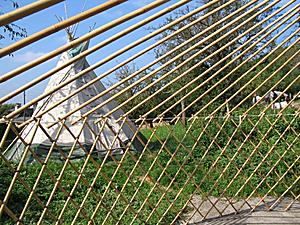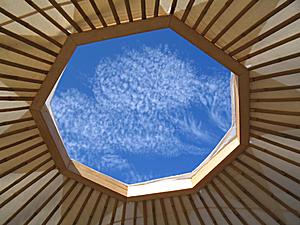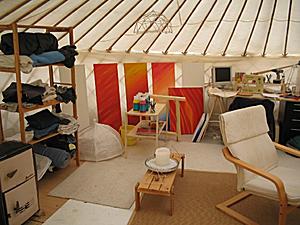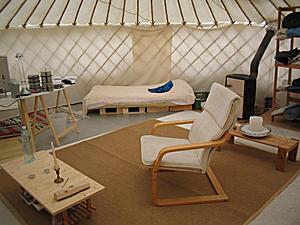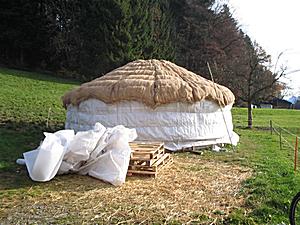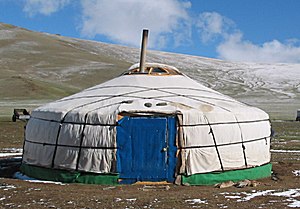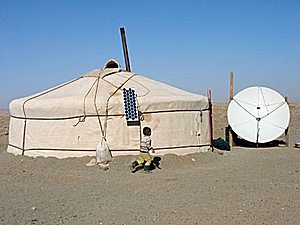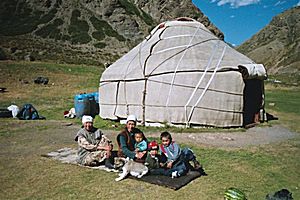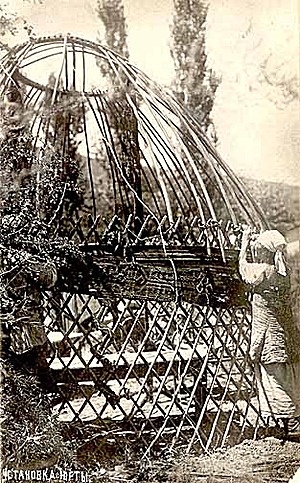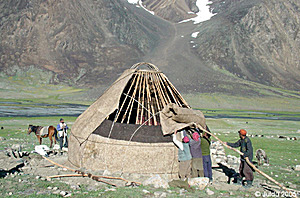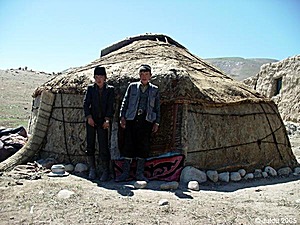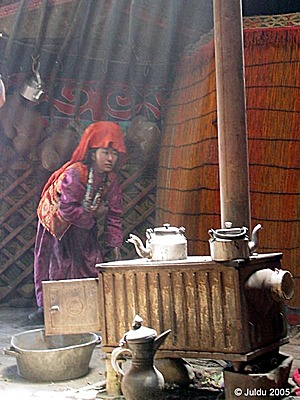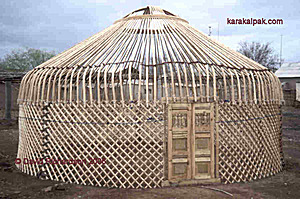Russian: Yurta, Mongolian: Ger - which means dwelling or house.
While preparing my wintertime (2005/2006) living in nature, or close to nature, either tipi or another shelter form, I discovered the Yurt, a highly transportable shelter which can be put up and taken down within a few hours, and possibility to thermal insulate fully for whole year habitat in colder regions - ideal for nomadic living.
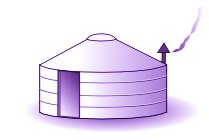 |
The yurt is very light in weight, and in particular when bamboo for the wall and roof poles is used. The thermal insulation can be felt, or quilted blankets filled with straw, hemp or shredded treebark, or for low-budget bubble wrap does it as well til -5°C only (4 layers), and keeps the interior of the yurt daylight bright.
| Simplicity |      |
| Portability |      |
| Comfort |      |
| Size Flexibility |      |
| Overall |      (3.5) (3.5) |
In order to get to know yurts I visited a yurt village here in Switzerland in 2005, and met other people who built their own yurt.
The past years since I built my own yurt (fall 2005) I wrote down some notes and started a diary, both are listed below.
My Yurt / Ger Notes, Calculator & Diary
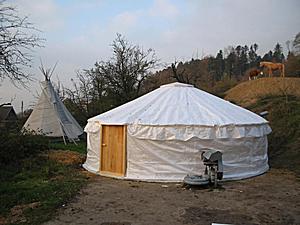  My 6.4m yurt I built for winter time 2005/2006 |
- Yurt Notes, yurt math and online calculator to calc the yurt geometry, and details on various parts of the yurt:
- Yurt Math: some math definitions and expressions
- Yurt Calculator: interactively calculate all parts (poles, canvas, etc)
- Crown Wheel / Toono
- Wall / Khana
- Door / Khaalga
- Insulation
- Floor / Shal
- How to develop a standard
- How to pitch / erect / put-up a yurt
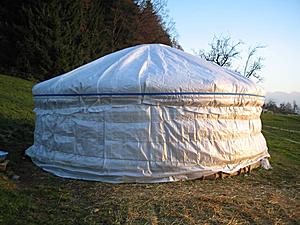  My 6.4m yurt in winter 2006/2007 with upgrades |
- Yurt Diary, my personal endevour building a yurt according the notes I collected:
- Starting building my first yurt (6.4m diameter)
- Going through winter 2005/2006
- Extensions, considerations, heating, wind
- Spring 2006, warmth; Summer 2006 with heat
- Starting building more bigger yurts, and a few wonderful photos
- Moving to new place for 2006/2007, nearby
- Adding new straw filled jute blankets as winter insulation
- Building a small 4m travel yurt
In case you plan to build your own yurt, check the "How To Manuals" before you study my notes more in-depth.
How To Manuals
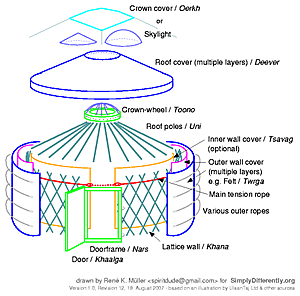  Overview of Yurt/Ger Construction |
- Build your own Yurt
 (PDF) by Paul King, good overview
(PDF) by Paul King, good overview
- Building a Mongolian Yurt
 (PDF) by Sir Ogami Akira, most detailed plans
(PDF) by Sir Ogami Akira, most detailed plans
- The Construction of a Yurt
 (PDF) by Ellisif Fkakkari
(PDF) by Ellisif Fkakkari
Other People's Yurts
People I visited myself:
- Chris Aeppli, Winterthur (Switzerland), lives in a 7.5m yurt insulated with hempmats and has a travel agency offering guided trips in Mongolia
- Claudius Kern, Graz (Austria), developed a 2-level yurt he lives in
- Yurt Village (Switzerland) aka Jurtendorf, Huttwil (Switzerland), group of people living in yurts and offering seminars, workshops during summer
Other personal diaries I found on the net:
- UB Mongolia: Ger Construction
 , native mongolian ger/yurt construction photos
, native mongolian ger/yurt construction photos
- Lars' Yurt Page
 , detailed photo album
, detailed photo album
- Glenn-Sha's Ger Page
 , hints and how to avoid common mistakes
, hints and how to avoid common mistakes
- Barefoot Boy: Yurt Diary
 , including kitchen and other interior enhancements
, including kitchen and other interior enhancements
Links
- YurtInfo.org
 , dedicated organization promoting yurts, initiated by Becky Kemery
, dedicated organization promoting yurts, initiated by Becky Kemery
Forums
- YurtInfo Forum
 , also post without registration
, also post without registration
- The Yurt Community
 , small group discussing everything around yurts (requires yahoo account)
, small group discussing everything around yurts (requires yahoo account)
Commercial Sites
- Mongolia:
- UlaanTaij.com
 , mongolian manufacturer, exports to Europe / USA
, mongolian manufacturer, exports to Europe / USA
- Z&F Mongolia
 , exports to Europe / USA
, exports to Europe / USA
- UlaanTaij.com
- Europe:
- Germany: Jurte.com
 , german web-site, original mongolian yurts
, german web-site, original mongolian yurts
- Germany/Mongolia: Jurte.info
 , original mongolian yurt exported from Mongolia
, original mongolian yurt exported from Mongolia
- Czech Republic: YourTent.com
 , traditional mongolian/kirgize yurts, workshop & sell, lot's of links to other sites
, traditional mongolian/kirgize yurts, workshop & sell, lot's of links to other sites
- Austria: Claudius Kern
 , helds workshops and builds modern yurts on demand
, helds workshops and builds modern yurts on demand
- Switzerland: Jurtendorf.ch
 , yurt village, resides in Switzerland, to rent & sell
, yurt village, resides in Switzerland, to rent & sell
- Netherlands: Nooitmeerhaast.nl
 , rent & sell - truly beautiful yurts
, rent & sell - truly beautiful yurts
- Italy: Yurta Silentbreeze.com
 - italian source of yurts
- italian source of yurts
- France: Yourte.fr
 , yurt the kirgiz style (bent roof poles)
, yurt the kirgiz style (bent roof poles)
- UK: Woodland Yurts UK
 , Paul Kings' company
, Paul Kings' company
- UK: SpiritsIntent.com
 , covered structures, nomadic dwellings, alternative homes, canvas tents and also do yurts
, covered structures, nomadic dwellings, alternative homes, canvas tents and also do yurts
- UK: Toby Fairlove Yurts
 , experienced yurt maker building also multi-yurts (clustered yurts)
, experienced yurt maker building also multi-yurts (clustered yurts)
- UK: Hearthworks Tipis & Yurts
 , sale and rent of tipis and yurts, event production, kyrgyz yurts
, sale and rent of tipis and yurts, event production, kyrgyz yurts
- UK: Simply Yurts
 , hire/rent of yurts
, hire/rent of yurts
- Spain: YurtWorkshop.com
 , skilled craftsman doing traditional yurts
, skilled craftsman doing traditional yurts
- Germany: Jurte.com
- USA:
- Yurt People.com
 , formerly grassroot movement living in yurts from where various yurt-building companies arose
, formerly grassroot movement living in yurts from where various yurt-building companies arose
- Colorado Yurt.com
 , comfort yurts with multiple options
, comfort yurts with multiple options
- Pacific Yurts.com
 , comfort yurt, beautiful pictures
, comfort yurt, beautiful pictures
- SpiritMountainYurts.com
 , durable yurts made with vinyl cover
, durable yurts made with vinyl cover
- GoYurt.com
 , "truly transportable" yurts (13')
, "truly transportable" yurts (13')
- ShelterDesigns.net
 , handmade yurts from Montana USA
, handmade yurts from Montana USA
- Laurel Nest Yurts
 , North Carolina USA
, North Carolina USA
- Yurt People.com
References
- "The complete Yurt handbook" by Paul King
 , ISBN 1-899233-08-3
, ISBN 1-899233-08-3
Covers traditional mongolian yurt, good as a start - "Mongolian Cloud Houses", Dan Frank Kuehn
 , ISBN 0-936070-39-0
, ISBN 0-936070-39-0
Only read an excerpt but seems very good, paperback
Native Yurts
A small map of the region where yurts still are used for nomadic shelters:
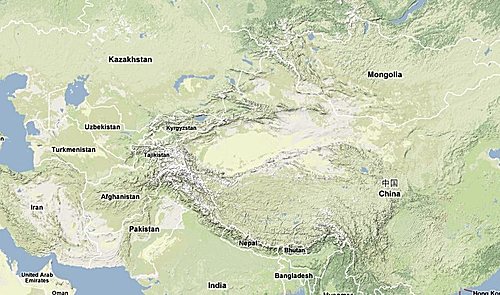  Region Map: Mongolian, Kazakhstan, Uzbekistan, Turkmenistan, Afghanistan, Kyrgyzstan and so forth |
For reference consideration some native yurt approaches with a bit detail observation:
Mongolia
  Former nomadic herders moving to Ulaanbaatar |
- The 2nd photo shows the traditional approach, felt-based insulation, multiple sections (not one piece), dedicated outer rain wall section which reaches the ground (green), multiple ropes stretching over the roof to fasten against strong winds, the roof pipe (and likely the stove positioned in the center of the yurt) reaching through the crown-wheel/toono, which is sealed with glass, part of the top cover folded aside so the pipe goes through. The roof is rather flat, 20-25°; in other words no or very little snow fall expected, the background shows yet some snow.
- The 3rd photo shows the bridge of modern technology like solar electric panal and a satellite TV, cotton cover and stove pipe through crown-wheel/toono, desert like environment
Kyrgyzstan
The kyrgyz (kirgiz) yurt is slightly different than the mongolian, as it has bent roof poles:

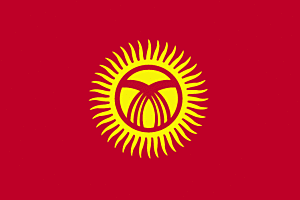  Kyrgyzstan Flag; Toono / Yurt Roof-Wheel with sun flames representing the 40 kyrgyz tribes |
- The yurt has a cloth-like felt door, to roll up and down, interestingly the stove pipe goes through the roof on the side and not through the crown-wheel/toono, the wall seems more conic than straight. The cover seems wool felt without the additional white cotton cover.
- The 2nd photo shows a yurt with very steep roof, likely ~45°, with cotton cover and ribbons to keep the roof parts attached to the yurt.
Afghanistan
Following photos were kindly provided by Julien Dufour :
:
- On the first photo you see that the roof cover is made not by one piece, but multiple sheets which have cords attached, to tie to each other. There is no ladder used to put up the rain cover, the steep angle shows (>45°) that snow likely won't stick on the roof.
- The second photo with the two young men you see the outer layer sealed with stones on the floor - the overall shape of the yurt seems a bit uneven and asymmetric, likely due the roof poles.
- The third photo shows a woman cooking on the central placed stove, the stove pipe reaching through the crown-wheel/toono. The room separating cover seems woven grass.
Uzbekistan/Karakalpakstan
Karakalpakstan  is an autonomous republic of Uzbekistan, the following photos were kindly provided by David Richardson
is an autonomous republic of Uzbekistan, the following photos were kindly provided by David Richardson  :
:
- Very steep roof, apprx. 45°, multiple layers of rain cover, ribbons which keep those covers on the roof, as well artistic ribbons. The roof is a rolleable cloth. The router wall cover woven reed, so called shiy, a thin but unflexible rush-like steppe grass also known as chee grass in english.
- The yurt frame shows that the width of the lattice wall junctions rather narrow, ~ 15 cm, apprx. 7 roof poles on a 100cm wide door ~ 15cm, whereas every 4th of 21 junctions of the lattice wall is not fixated. The inner lattice wall lath go from top left to bottom right, whereas kazakh, uzbekh and kirgiz yurts go from bottom left to top right. The roof poles are fixated with individual wrap around each roof pole, to separate the roof poles with a given distance.
The yurts are generally much heavier as the yurts aren't dislocated once raised , according David Richardson.
For more information please consider to visit Karakalpak.com  .
.

